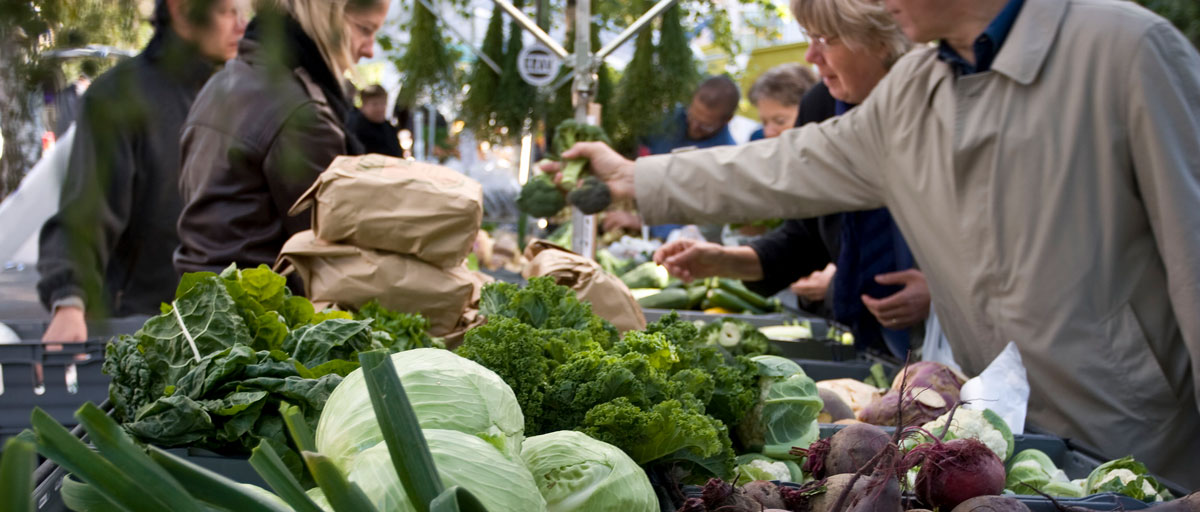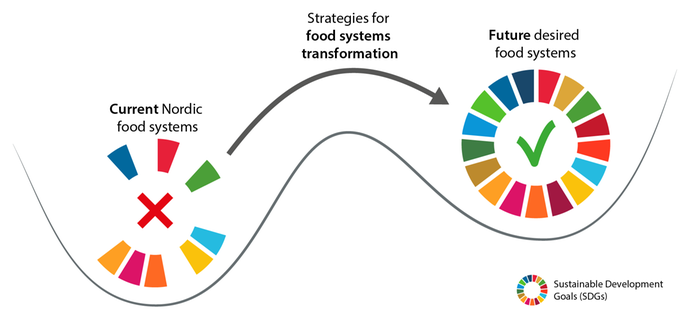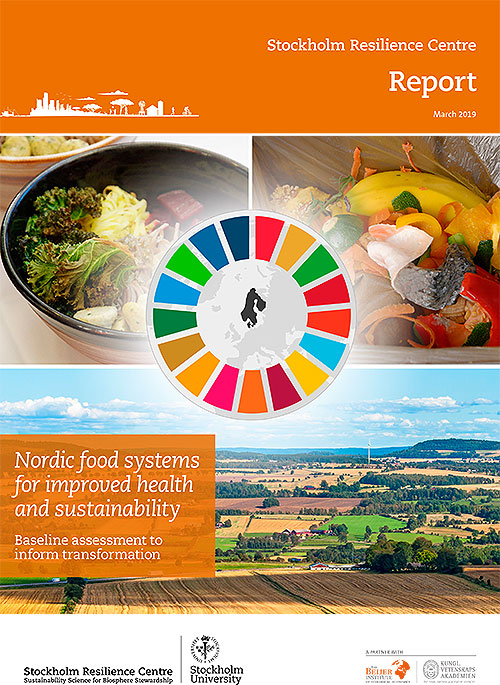
If the Nordics live up to their great potential for innovative solutions, they can provide the global community with a much-needed example of food systems that help deliver on the global goals for sustainable development, says a report written by researchers from Sweden and Austria, commissioned by the National Food Agency in Sweden. Photo: N. Kruys/Azote
Bildtext får vara max två rader text. Hela texten ska högerjusteras om den bara ska innehålla fotobyline! Photo: B. Christensen/Azote
Nordic food systems
Within reach
Nordics in unique position to lead global food transformation, but not without overcoming major challenges
- Nordic countries can be a perfect leader in making the global food system healthier and more sustainable, but they are falling short on several dietary, health and environmental goals
- Current diets in Norway, Sweden, Denmark and Finland* are contributing both to public health problems and a range of environmental impacts
- The report is the first independent, regional assessment of the EAT-Lancet Commission’s proposed global targets for healthy diets and environmentally sustainable food production
Nordic countries can be a perfect leader in making the global food system healthier and more sustainable, but so far they are falling short on several dietary, health and environmental goals. Current diets in Norway, Sweden, Denmark and Finland* are contributing both to public health problems and a range of environmental impacts.
About half the population is overweight, meat consumption is at least 4.5 times in excess of EAT-Lancet guidelines and food waste is a major problem. Yet, the Nordics can build upon the many strengths of their food systems – including world-class dietary guidelines, strict agricultural regulations and innovative solutions to societal challenges – to show the world that healthy and sustainable diets are within reach. These are some of the conclusions of a report written by researchers from Sweden and Austria, commissioned by the National Food Agency in Sweden. Pdf, 5.2 MB.
Pdf, 5.2 MB.
Incredible potential
The report is the first independent, regional assessment of the EAT-Lancet Commission’s proposed global targets for healthy diets and environmentally sustainable food production**. The EAT-Lancet Commission’s report, which was launched in January 2019, demonstrates why diet and food production must radically change to improve health and avoid potentially catastrophic damage to the planet. The new report Pdf, 5.2 MB. aims to make the EAT-Lancet targets more meaningful for policy makers, businesses and individuals in the Nordics, and presents a baseline of Nordic food system performance using more local data.
Pdf, 5.2 MB. aims to make the EAT-Lancet targets more meaningful for policy makers, businesses and individuals in the Nordics, and presents a baseline of Nordic food system performance using more local data.
The assessment highlights the many bright spots of Nordic food systems, including dietary guidelines that championed the integration of sustainability, healthy school meals, low antibiotic use in livestock and high animal welfare. Despite this, Nordic food systems are failing to meet several dietary, health and environmental goals.
Our report shows that the Nordics have incredible potential to become world leaders in truly healthy and sustainable food systems, but we are not there yet. There is still work to be done if the Nordics are to achieve our health and environmental goals
Amanda Wood, co-author to the report
Across the Nordics, people are eating several extra teaspoons of sugar each day and about 4.5 to 9 times the amount of red meat recommended by the EAT-Lancet. And, they are still not eating green enough. In 2014, only about 13% of the Nordic adult population (including Iceland) reached the 500 g a day goal for fruits and vegetables. Legumes and nuts could also be much more common on the Nordic plate.
Why the Nords need to change
The report highlights several reasons why the Nordic populations need to change what they eat. First is for their health. About half of Nordic adults are currently above a healthy weight, and unhealthy diets are among the leading drivers of poor health across the region. Diets also need to change for the environment. The researchers estimate that the average Nordic diet produces nearly three times the greenhouse gas emissions recommended by the EAT-Lancet, and use nearly twice the land area.
Wood and her colleagues also stress that the way Nordic countries produce and consume food has environmental consequences far beyond their own borders. “We must recognize that Nordic food systems are truly global food systems. Nordic food is exported all around the world and foods from around the world are part of Nordic diets. The environmental costs of all this must be better accounted for, and it's encouraging that projects like PRINCE have already started this important work,” she says.
Finally, unhealthy diets come at a high cost to society. While few analyses have quantified health care costs of unhealthy diets in the Nordic region specifically, analyses from Norway indicate that a shift to more healthy diets could result in savings of approximately 16 billion EUR from accumulated health benefits, reduced health care costs and increased productivity.

Transformative strategies and policies will be needed to move Nordic food systems from their current state - where they are meeting some, but not all food system targets - to a future desired state where they contribute to the integrated set of 17 Sustainable Development Goals. Illustration: J. Lokrantz/Azote
Changes far beyond daily food habits
The analysis points to the benefits the Nordics could see from shifting diets to include more plant-based proteins like legumes and nuts while eating less red and processed meat and sugar. This is in line with current dietary recommendations in the Nordic countries which are based on the Nordic Nutrition Recommendations. To achieve more healthy diets requires changes far beyond individuals’ daily food habits.
“The changes we are calling for require food producers, retailers and governments to enable consumers to make healthier and more sustainable choices, halve our food loss and waste, and ensure that our production here and abroad meets environmental goals,” says co-author Line Gordon, director of the SRC.
These sweeping changes will require breaking down the silos that currently keep work on food systems separate. The authors call for extensive collaboration across sectors in order to agree on a common vision for Nordic food systems and then develop coherent solutions.
“When we work together, we can make sure that one action isn’t undermining another. For example, a country can have fantastic dietary guidance, but if they import, produce and sell unhealthy and unsustainable foods, then those guidelines will be less effective,” says co-author Elin Röös, Swedish University of Agricultural Sciences, Uppsala, Sweden.
Being the leader not the same as reaching goals
The researchers point out that there is enough evidence and knowledge to begin action towards healthier and more sustainable food production and consumption. “Nordic policy makers, researchers, producers, civil society groups and businesses have enough evidence to improve Nordic food systems,” they write.
Although each Nordic country has a distinct food system, all countries collaborate and use the Nordic Nutrition Recommendations as a base from which to build national dietary guidelines. They also share certain characteristics that give them the potential to deliver on multiple of the Sustainable Development Goals, a collection of 17 global goals set by the United Nations in 2015.
“The Nordics are no stranger to being at the head of the pack,” says Amanda Wood.
“But we have to remember that being the leader isn’t the same as reaching our goals. If the Nordics live up to their great potential for innovative solutions, they can provide the global community with a much-needed example of food systems that help deliver on the global goals for sustainable development.”
Background information
The Stockholm Resilience Centre was approached by Livsmedelsverket to undertake
an initial analysis of what food systems transformations might look like, based on the findings from the EAT-Lancet Commission Report on Healthy Diets from Sustainable Food Systems. The report is thus not commissioned by the Lancet or EAT but produced through in-kind time from a team of researchers passionate about driving forward food system transformations.
* Due to resource and time constraints, the authors relied on several previous analyses, which did not include Iceland.
Amanda Wood explores how food policy, governance and multi-stakeholder collaborations can support healthy and sustainable food systems.
Line Gordon is the director of the Stockholm Resilience Centre and an internationally recognised scientist in sustainability of water, food, and the biosphere.
Tiina Häyhä’s research interests include exploring challenges of human development and global environmental sustainability. Her current research focuses on developing approaches for operationalising the planetary boundaries framework at sub-global scales and for different sectors.
Victoria Bignet is a PhD candidate with particular focus on sustainable and healthy diets. She holds an MSc. degree with Distinction in Environmental Change & Management from the University of Oxford
Louise Hård af Segerstad is a communication strategist working to enhance and facilitate the interactions between research and the rest of society












